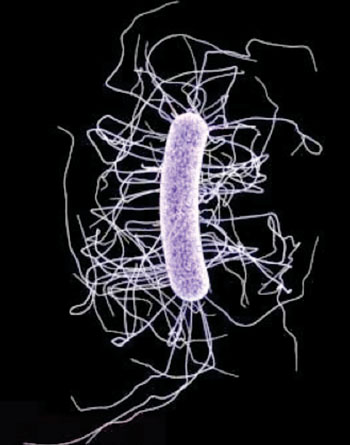Increased Clostridium Difficile Infections Due to Antibiotic Misuse
By LabMedica International staff writers
Posted on 12 Mar 2015
Changes in the epidemiology of Clostridium difficile infections have occurred since the emergence of the North American pulsed-field gel electrophoresis type 1 (NAP1) strain, which has been responsible for geographically dispersed hospital-associated outbreaks.Posted on 12 Mar 2015
Clostridium difficile is a bacterium that causes colitis and inflammation of the colon and infection can occur through touching surfaces or items that are contaminated with feces, in which the bacteria are is shed. People who are taking antibiotics for other illnesses are most prone to C. difficile infection as antibiotics can destroy some of the friendly bacteria in the gut, meaning it may be less protected against C. difficile.

Image: The ultrastructural morphology exhibited by a single Gram-positive Clostridium difficile bacillus (Photo courtesy of Melissa Brower/CDC).
A team of investigators led by those at the Centers for Disease Control and Prevention (CDC; Atlanta, GA, USA) identified all positive C. difficile test results from 88 inpatient and 33 outpatient laboratories serving residents in surveillance areas in 2011. A case of C. difficile infection was defined as a positive result on a C. difficile toxin or molecular assay of a stool specimen obtained from a surveillance-area resident at least one year of age who had not had a positive assay in the previous eight weeks. Recovered isolates underwent pulsed-field gel electrophoresis (PFGE) and also underwent polymerase-chain-reaction (PCR) assay to detect the presence of particular genes.
A total of 15,461 cases of C. difficile infection were identified in the 10 geographic areas; 65.8% were healthcare associated, but only 24.2% had onset during hospitalization. The North American pulsed-field gel electrophoresis type 1 (NAP1) strain was more prevalent among healthcare-associated infections than among community-associated infections. The study found that individuals aged 65 and older are particularly vulnerable to C. difficile infection. Around one in three cases occurred among patients in this age group, and they also accounted for two in three healthcare-associated C. difficile infections. What is more, around 80% of C. difficile-attributable deaths occurred in patients aged 65 or older.
The team also identified an increased risk of C. difficile infection among women and Caucasian individuals.
The CDC say these results indicate that improved antibiotic use and infection control needs to be put in place for outpatient health care, as well as inpatient facilities. Michael Bell, MD, deputy director of the Division of Healthcare Quality and Promotion at the CDC, said, “Overall, there are two main things that need to be improved. Number one is how antibiotics are being used, making sure that we use them when they're truly necessary and only for as long as necessary. The second element is to ensure rigorous infection control in all health care settings. C. difficile infections must be diagnosed quickly and correctly so that the infected patient can be cared for using the right infection control techniques.” The study was published on February 26, 2015, in the New England Journal of Medicine.
Related Links:
The Centers for Disease Control and Prevention














